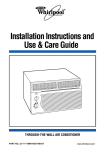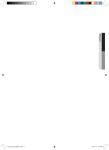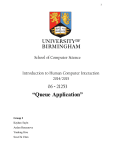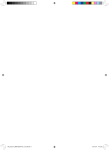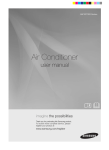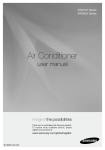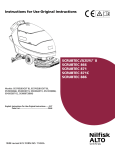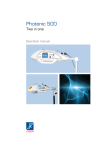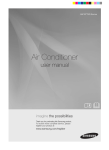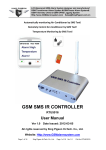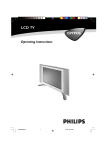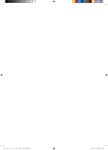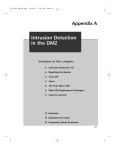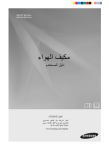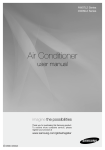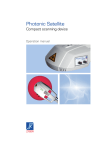Download Samsung AW18ECEDAWQ User Manual
Transcript
AW18*CED Series AW24*CED Series Air Conditioner user manual imagine the possibilities Thank you for purchasing this Samsung product. To receive more complete service, please register your product at www.samsung.com/register M project W??_33005A_E.indd 27 2011-1-11 17:41:02 features of your new air conditioner • Cool Summer Offer On those hot sweltering summer days and long restless nights, there is no better escape from the heat than the cool comforts of home. Your new air conditioner brings an end to exhausting hot summer days and lets you rest. This summer, beat the heat with your own air conditioner. • Easy Maintenance Cleaning and maintenance are no longer a chore. Simply remove the air filter inside the air conditioner, rinse, and dry for clean fresh air. Breathe a sigh of relief at knowing how easy it is to keep the air clean. • A Look for Everywhere The elegant and harmonious design gives priority to the esthetics of your space and complements any of your existing interior decor. With its soft-white color and rounded-edge shape, the new air conditioner adds class to any room. Enjoy what your air conditioner offers both functionally and esthetically. • Advanced Timer Function Imagine your home filled with cool air from long day of work or school. You can set the timer to automatically turn on and off the air conditioner even when you are not home. For easy future reference write the model and serial number down. You will find your model number on the bottom side of the air conditioner. Model # Serial # 02_ features M project W��_33005A_E.indd 2 2011-1-11 17:40:01 safety information To prevent electric shock, disconnect the power before servicing, cleaning, and installing the unit. SAFETY INFORMATION Before using your new air conditioner, please read this manual thoroughly to ensure that you know how to safely and efficiently operate the extensive features and functions of your new appliance. What the icons and signs in this user manual mean: WARNING CAUTION CAUTION ENGLISH Because the following operating instructions cover various models, the characteristics of your air conditioner may differ slightly from those described in this manual. If you have questions, call your nearest contact center or find help and information online at www.samsung.com. Risk of death or serious personal injury. Potential risk of personal injury or material damage. To reduce the risk of fire, explosion, electric shock, or personal injury when using your air conditioner, follow these basic safety instructions: Do NOT attempt. Do NOT disassemble. Do NOT touch. Follow directions carefully. Unplug the power plug from the wall socket. Make sure the machine is grounded to prevent electric shock. Call the contact center for help. Recommended instructions or useful information for use. These warning signs are here to prevent injury to you and others. Please follow them carefully. After reading this section, keep it in a safe place for future reference. safety information _03 M project W��_33005A_E.indd 3 2011-1-11 17:40:01 safety information SEVERE WARNING SIGNS WARNING Do not place the air conditioner near hazardous substances or equipment that releases free flames to avoid fire, explosions or injuries. • Potential risk of fire hazard or explosion. Do not install the outdoor unit at an unstable place or elevated surface where there is potential risk of falling. • If the outdoor unit falls, it may cause personal injury or loss of property. Failure or damage may occur if any changes or modification that is not stated in the installation manual was performed. In this case, user will be responsible for the repair expenses. Install the air conditioner away from direct exposure to sunlight, heating apparatus, and humid places. • Hang curtains on windows to boost cooling efficiency and to avoid the risk of electric shock. Do not cut the power plug and connect to a different power cable. Do not yank the power cable and touch the power plug with hands. • Potential risk of fire or electric shock. Never use a damaged or dusted power plug, power cable, or loosened power receptacle. • Potential risk of fire or electric shock. Install an exclusive circuit breaker and short-circuit breaker for the air conditioner. • Potential risk of electric shock or fire. Do not insert anything such as fingers or branches into the air conditioner vents while the air conditioner is running. • Keep the children away from the air conditioner to prevent them from putting their finger on the air conditioner. Potential risk of personal injury. Ensure no water gets into the air conditioner. • Potential risk or electric shock. • If the water gets into the air conditioner, stop and unplug the power source immediately. Turn off the air conditioner using the provided remote control or control accessory (if provided). Do not unplug to turn off the unit (unless there is an immediate danger). Do not run the air conditioner for an extended period of time in a room with the door closed or with babies, elderly or disabled people. • Open the door or windows to ventilate your room at least once an hour to prevent oxygen shortage. The air conditioner is composed of moving parts. Keep children away from the unit to avoid physical injury. 04_ safety information M project W��_33005A_E.indd 4 2011-1-11 17:40:01 Make sure that children take precautions against access to the air conditioner and they do not play with the unit. Do not clean the interior of air conditioner on your own. • You may damage the parts which can cause electric shock or fire. • Consult contact center for cleaning the interior of the air conditioner. Do not connect the air conditioner with heating apparatus or attempt to disassemble, remodel or repair it yourself. Consult the place of purchase or contact center to install, reinstall or disassemble the air conditioner. • Improper installation carries a risk of unit malfunction, water leakage, electric shock or fire. • If installing in specialty areas, such as a factory complex or saline coastal area, consult the place of purchase or contact center for specific installation details. • The units must be installed according to distances declared, in order to permit accessibility from each side, either to guarantee correct operation of maintenance or repairing products. The unit’s parts must be reachable and removable completely under safety condition (for people or things). ENGLISH • Potential risk of malfunction, electric shock or fire. If repairs are needed, consult the contact center. Consult a dealer regarding the appropriate measures to prevent the allowable concentration from being exceeded. • If the refrigerant leaks, and cause the concentration limit to be exceeded, hazards due to lack of oxygen in the room may result. If the indoor unit gets wet, turn the power off immediately and call your nearest contact center. • Potential risk of fire or electric shock. The appliance is fitted with means for disconnection from the supply mains having a contact separation in all poles that provide full disconnection under overvoltage category III conditions, and these means must be incorporated in the fixed wiring in accordance with the wiring rules. In order to avoid a hazard due to inadvertent resetting of the thermal cutout,this appliance must not be supplied through an external switching device,such as a timer, or connected to a circuit that is regularly switched on and off by the utility. The appliance shall be installed in accordance with national wiring regulations. Always make sure that the power supply is compliant with current safety standards. Always install the air conditioner in compliance with current local safety standards. Verify that the voltage and frequency of the power supply comply with the specifications and that the installed power is sufficient to ensure the operation of any other domestic appliance connected to the same electric lines. Use a rated circuit breaker only. • Never use steel wires or copper wires as a circuit breaker. It may cause fire or unit malfunctions. Do not put undue stress or place heavy object on the power cable. Do not bend the power cable excessively. • Potential risk of fire or electric shock. To protect the product from water and possible shock, you should keep the power cable and the connection cord of the indoor and outdoor units in the protection tube. When opening or closing the front panel, use a stable stool and watch your steps carefully. Disconnect the air conditioner from power supply before it is repaired or disassembled. Clean the air conditioner after the inner fan stops operating. • Potential risk of injury or electric shock. safety information _05 M project W��_33005A_E.indd 5 2011-1-11 17:40:01 safety information SEVERE WARNING SIGNS (Cont’d) WARNING Use a receptacle that has a ground terminal. The receptacle must be used exclusively for the air conditioner. • Improper electrical grounding may cause electric shock or fire. Be sure to ground the unit. Do not connect the ground wire to gas or water pipes, lighting rods, or telephone grounding lines. • If the unit is not properly grounded, electric shock may result. If you smell burning plastic, hear strange sounds, or see smoke coming from the unit, unplug the air conditioner immediately and call a contact center. • Potential risk of fire or electric shock. CAUTION SIGNS CAUTION Do not block or place items in front of the air conditioner. Do not step, hang onto, or place heavy items on the air conditioner. • Potential risk of personal injury. If failure or damage occurs on the conditions of improper use not followed by the installation manual, there will be an extra labor charge for installing and construction. • Potential risk of malfunction, electric shock or fire if repairs or installations are attempted by a non-qualified service technician. Do not spray flammable gases such as insecticide near the air conditioner. • Potential risk of electric shock, fire or unit malfunction. Do not open the front grille during operation. • Potential risk of electric shock or unit malfunction. Cool air should not flow directly towards people, pets, and plants. • It is harmful to your health, pets, and plants. Do not drink drain water coming out of the air conditioner. • Potential risk of health hazard. Do not allow children to climb on the air conditioner. Do not use the air conditioner as a cooling precision instrument for food, pets, plants, cosmetics or machinery. Do not pull or give excessive shock to the air conditioner. • Potential risk of fire, or unit malfunction and there are risk of personal injury because unit may fall down. Do not spray water directly on the air conditioner or use benzene, thinner or alcohol to clean the surface of the unit. • Potential risk of electric shock or fire. • Potential risk of damage to the air conditioner. Do not place any objects, especially containers with liquid. 06_ safety information M project W��_33005A_E.indd 6 2011-1-11 17:40:01 Do not touch the pipe connected to the air conditioner. Install the indoor unit away from lighting apparatus using the ballast. • If you use the wireless remote control, reception error may occur due to the ballast of the lighting apparatus. Install the outdoor unit where operating noise and vibration will not disturb your neighbor and in a well-ventilated area with no obstacle. ENGLISH • Potential risk of malfunction. • Operating noise may disturb your neighbor. Make sure that there are no obstacles or covers that block the air conditioner. Allow sufficient space for air circulation. • Insufficient ventilation may result in poor performance. If the supply cord is damaged, it must be replaced by the manufacturer, its service agent or similarly qualified persons in order to avoid a hazard. If a power outage occurs while the air conditioner is working, turn off the power source immediately. Max current is measured according to IEC standard for safety and current is measured according to ISO standard for energy efficiency. Check for damage on delivery. If damaged, do not install the air conditioner and call the place of purchase immediately. Keep indoor temperatures stable and not extremely cold, especially where there are children, elderly or disabled people. The packaging material and used batteries of the remote controller (optional) must be disposed of in accordance with the national standards. The refrigerant used in the air conditioner must be treated as chemical waste. Dispose the refrigerant following national standards. Have a qualified service technician install the air conditioner and perform a trial operation. Firmly connect the drain hose to the air conditioner for proper water drainage. Check for damages on the outdoor unit installation pad at least once a year. • Potential risk of personal injury or property loss. When using a wireless remote control, the distance should not be more than 7 meters from the air conditioner. If the remote control is not used for a long period of time, remove the batteries to prevent leakage of electrolyte. When cleaning the outdoor unit, touch the heat exchanger radiator fins with extreme care. • Wearing thick gloves can protect your hands. Make sure that the condensed water dripping from the drain hose runs out properly and safely. This appliance is not intended for use by persons (including children) with reduced physical, sensory or mental capabilities, or lack of experience and knowledge, unless they have been given supervision or instruction concerning use of the appliance by a person responsible for their safety. Children should be supervised to ensure that they do not play with the appliance. safety information _07 M project W��_33005A_E.indd 7 2011-1-11 17:40:01 safety information CAUTION SIGNS (Cont’d) CAUTION Inspect the condition, electric connections, pipes and external case of the air conditioner regularly by a qualified service technician. Do not open doors and windows in the room being cooled during operation unless necessary. Do not block the air conditioner vents. If objects block the air flow, it may cause unit malfunction or poor performance. Make sure there are no obstacles under the indoor unit. • Potential risk of fire or loss of property. The air conditioner should be used only for the applications for which it has been designed: the indoor unit is not suitable to be installed in areas used for laundry. Our units must be installed in compliance with the spaces indicated in the installation manual to ensure either accessibility from both sides or ability to perform routine maintenance and repairs. The units’ components must be accessible and that can be disassembled in conditions of complete safety either for people or things. For this reason, where it is not observed as indicated into the Installation Manual, the cost necessary to reach and repair the unit (in safety, as required by current regulations in force) with slings, trucks, scaffolding or any other means of elevation won’t be considered in-warranty and charged to end user. Ensure the off-on and protection switches are properly installed. Do not use the air conditioner if damaged. If problems occur, immediately stop operation and disconnect the plug from the power supply. If the air conditioner will not be used for an extended period of time (for example, over several months), unplug the power from the wall. Call the place of purchase or a contact center if repairs are needed. • Potential risk of fire or electric shock if disassembly or repairs are attempted by a non-qualified service technician. 08_ safety information M project W��_33005A_E.indd 8 2011-1-11 17:40:02 contents 10 10 10 11 12 12 Checking the parts and the control panel Main parts Ventilation lever Control panel Remote control Installing the batteries OPERATING YOUR AIR CONDITIONER 13 13 14 15 16 16 16 17 17 18 19 20 21 Selecting operation mode COOL DRY FAN Adjusting air flow direction Horizontal air flow Vertical air flow Advanced functions On timer Off timer HOUR/MIN SLEEP HOLD CLEANING AND MAINTAINING YOUR AIR CONDITIONER 22 22 22 Cleaning the exterior Cleaning the air filter Maintaining the air conditioner APPENDIX 23 23 Troubleshooting Operation ranges INSTALLING YOUR AIR CONDITIONER 24 24 24 25 25 Getting ready to install the air conditioner Checking included parts Selecting the best location Setting up the air conditioner Assembly for drainage 10 13 22 23 24 ENGLISH SETTING UP YOUR AIR CONDITIONER BEFORE USE contents _09 M project W��_33005A_E.indd 9 2011-1-11 17:40:02 setting up your air conditioner before use Congratulations on the purchase of the air conditioner. We hope you enjoy the features of your air conditioner and stay cool with optimal efficiency. Please read the user manual to get started and to make the best use of the air conditioner. CHECKING THE PARTS AND THE CONTROL PANEL Carefully unpack your air conditioner, and check the unit to make sure it is not damaged. Main parts • Your air conditioner may slightly differ from illustration shown above depending on your model. • The power plug for this model is supplied by local Samsung Sales Company. When connect the cables to the power plug by the Sales Company, the brown power cable is connected with line L, the sky-blue power cable is connected with line N, and the green-yellow power cable is ground wire. Ventilation lever The ventilation lever is designed to help you get fresh air from outdoors. It can also help prevent strong outdoor odors from entering the room through the air conditioner. The lever is located on the lower right side of the air flow blades. Sliding the ventilation lever to the right lets outdoor air enter the room, and sliding the lever to the left re-circulates existing air within the room. Depending on your model, the ventilation lever appearance and location may slightly differ. 10_ setting up M project W��_33005A_E.indd 10 2011-1-11 17:40:05 ENGLISH Sets the timer to turn on/off the air conditioner after elapsing a pre-set time automatically. Press this button while the air conditioner is off to activate On timer. Press this button while the air conditioner is on to activate Off timer. You can adjust time within 1~24 hours after pressing timer button. - Increases the time by 1 hour unit. - Decreases the time by 1 hour unit. Temperature reminder indicates the temperature. In COOL mode, the display shows the temperature you have set. In DRY mode, the display shows 25 . In FAN mode, the display shows the room temperature. setting up _11 DB98-30412A(CHANGE).indd 9 2012-1-4 17:09:03 12_ setting up DB98-30412A(CHANGE).indd 11 2012-1-4 17:09:04 operating your air conditioner SELECTING OPERATION MODE COOL 1. Turn on the air conditioner. Press the ENGLISH In Cool mode, the air conditioner will cool your room. You can adjust the temperature and the fan speed to feel cooler in hot season. button on the remote control. 2. Set the operating mode. Press the MODE button on the remote control until in bold appears beside COOL mode. 3. Set the temperature. Press the TEMP or button on the remote control to increase or decrease the desired temperature. You can set the desired temperature between the range of 16˚C~ 32˚C. You can increase/decrease the temperature by 1˚C. • When you are using the remote control, make sure corresponding indicator appears on the display. • If current outside temperatures are much higher than the selected indoor temperature, it may take time to bring the inner temperature to the desired coolness. • Air flow can also be adjusted manually. (See page 17 for instructions.) • Avoid drastically turning down the temperature. Otherwise energy would be wasted and the room doesn't be cooled faster. 13_ operating M project W��_33005A_E.indd 14 2011-1-11 17:40:18 operating your air conditioner SELECTING OPERATION MODE DRY The air conditioner in Dry mode acts like a dehumidifier by removing moisture from the indoor air. Dry mode makes the air feel refreshing in a humid climate. 1. Turn on the air conditioner. Press the button on the remote control. 2. Set the operating mode. Press the MODE button on the remote control until in bold appears beside DRY mode. • When you are using the remote control, make sure corresponding indicator appears on the display. • Fan speed and temperature cannot be adjusted while using this mode. • Air flow can also be adjusted manually. (See page 17 for instructions.) 14_ operating M project W��_33005A_E.indd 15 2011-1-11 17:40:24 operating your air conditioner SELECTING OPERATION MODE FAN 1. Turn on the air conditioner. ENGLISH Fan mode can be selected to ventilate your room. Fan mode will be helpful to refresh the stale air in your room. button on the remote control. Press the 2. Set the operating mode. Press the MODE button on the remote control until in bold appears beside FAN mode. At the same time, indicator appears on the display. 3. Set the fan speed. Press the button on the remote control to set the desired fan speed. One of the following icons will appear on the display. Low fan speed is activated. Medium fan speed is activated. High fan speed is activated. 4. Open/block the vents. Slide the lever towards the right to ventilate the room with fresh air and the left to block. • In FAN mode, temperature can be set from 16 -32 by the remote control. However, this setting can hardly change the room temperature. • When you are using the remote control, make sure corresponding indicator appears on the display. • Air flow can also be adjusted manually. (See page 17 for instructions.) operating _15 M project W��_33005A_E.indd 16 2011-1-11 17:40:31 ADJUSTING THE AIR FLOW DIRECTION Air flow can be directed to your desired position. Horizontal air flow 1. Press the SWINGbutton on the remote control. 2. The inner air flow blades move from side to side continuously to circulate the air. 3. To keep the air flow direction in a constant position, press the SWINGbutton on the remote control. Vertical air flow 1. Move the vertical air flow blades up or down to the desired direction with your fingers. CAUTION Be extremely careful with your fingers while adjusting the Vertical air flow direction.There is a potential risk of personal injury when the unit is mishandled. While the air conditioner cools the room, keep the blades towards upwards. If let blades towards downwards in a constant time, moisture may be generated. Thus carries the risk of electric shock or unit malfunction. 16_ operating M project W��_33005A_E.indd 17 2011-1-11 17:40:35 operating your air conditioner ADVANCED FUNCTIONS This advanced function allows you to turn on/off your air conditioner automatically even when you are away. Simply set the time and your air conditioner will turn on/off automatically even when you are not home. ENGLISH On timer This function allows you to turn on the air conditioner automatically within the time range of 24 hours. On timer is available while your air conditioner is off. 1. Press the TIMER button on the remote control. indicator appears on the display. 2. Set the time you want the air conditioner to turn on automatically. Each time you press the button, time will increase in hourly unit and you can set it up to 24 hours. 3. Set the operating mode. Press MODE button to select COOL,DRY,FAN mode on the remote control. • Temperature/Fan speed can also be adjusted. (See page 14~15 for instructions.) • All the indicators other than Timer indicator will disappear approximately after 5 seconds after the setup. To deactivate On timer 1. Press the TIMER button on the remote control until you see the real time display. On timer you set will be canceled and On timer indicator will disappear. operating _17 M project W��_33005A_E.indd 18 2011-1-17 13:58:30 Off timer This function allows you to turn off the air conditioner automatically within the time range of 24 hours. Off timer is available while your air conditioner is on. 1. Press the TIMER button on the remote control. indicator will appear on the remote control display. 2. Set the time you want the air conditioner to turn off automatically. Each time you press the timer button, time will increase in hourly unit and you can set it up to 24 hours. Operating mode, Temperature and Fan speed can be adjusted before setting Off timer.Fan mode can not be selected in off timer mode. (See pages 14~15 for instructions.) To deactivate Off timer 1. Press the TIMER button on the remote control until you see the real time display. Off timer you set will be canceled and Off timer indicator will disappear. 18_ operating M project W��_33005A_E.indd 19 2011-1-11 17:40:45 operating your air conditioner SELECTING OPERATION MODE HOUR/MIN This function enables you to set the time in the display of remote control. ENGLISH 1. Turn on the air conditioner. Press the button on the remote control. 2. Set the time. Press the HOUR button for three seconds. Display starts flashing. Press the HOUR/MIN button again to increase the time by 1hr/1min. The value of HOUR ranges from 0 to 23. The value of MIN ranges from 0 to 59. After time setting, press to exit the mode. • Time setting is not available when timer is on. • In time setting mode, pressing button will not disable the normal operation of air conditioner. operating _19 M project W��_33005A_E.indd 14 2011-1-11 17:40:18 operating your air conditioner ADVANCED FUNCTIONS SLEEP This function will be helpful to enjoy your sleep. The temperature will be set to give you maximum comfort during your sleep. 1. Turn on the air conditioner. Press the button on the remote control. 2. Set the SLEEP mode on. Press the SLEEP button on the remote control until in bold appears beside the SLEEP. will appear on the display, Temperature changes in SLEEP mode Cool mode In cool mode,press SLEEP button,the temperature will imcrease 1 °C in an hour and it will increase another 1°C in the second hour before remaining constant. In dry and fan modes, press SLEEP button, the temperature will not change. To deactivate SLEEP mode 1. Press the SLEEP button on the remote control. SLEEP mode will be canceled. The display will show its earlier temperature and icons. • SLEEP mode is only effectual in Cool mode. • Air flow can also be adjusted manually. (See page 17 for instructions.) 20_ operating M project W��_33005A_E.indd 20 2011-1-17 14:00:44 operating your air conditioner ADVANCED FUNCTIONS HOLD ENGLISH This function is to lock or unlock the key board. After you set the operating mode, this button prevents the mode from changing by mispress/misclick. 1. Turn on the air conditioner. Press the button on the remote control. 2. Set the operating mode. Press the MODE button to set COOL,DRY, or FAN. 3. Set the HOLD mode on. Press the HOLD button to lock the keyboard. in bold appears beside HOLD mode. The other buttons are invalid now. To deactivate HOLD mode. 1. Press the HOLD button on the remote control. HOLD mode will be cancelled and the keyboard is unlocked. You can select a new mode again. 21_ operating M project W��_33005A_E.indd 14 2011-1-11 17:40:18 cleaning and maintaining your air conditioner When cleaning the filter, make sure to unplug the power from the unit. No special tools are needed to clean it. CLEANING THE EXTERIOR 1. Wipe the surface of the appliance with a slightly wet or dry cloth when needed. CAUTION Do not use Benzene, Thinner or CloroxTM. They may damage the surface of the unit and can create a risk of fire. CLEANING THE AIR FILTER 1. Open the front panel. Tightly grab front side of the front panel and pull it out. 2. Grab the air filter and slide it out. 3. Clean the Air filter with a vacuum cleaner or soft brush. If dust is too heavy, then rinse it with running water and dry it in a ventilated area. Air filter • For best conditions, repeat every two weeks. • If the air filter dries in a confined (or humid) area, odors may generate. If this occurs, re-clean and dry in a well-ventilated area. 4. Insert the Air filter back in its original position. 5. Close the front panel. MAINTAINING THE AIR CONDITIONER If the air conditioner will not be used for an extended period of time, dry it thoroughly and disconnect from the wall. There may be internal damage if moisture is left in its components. 1. Before storing the appliance, operate the air conditioner in Fan mode for three to four hours to dry the air conditioner completely. 2. Upon removing from storage, dry the inner components of the air conditioner again by running in Fan mode for three to four hours. This helps remove odors which may have generated from dampness. 22_ cleaning and maintaining M project W��_33005A_E.indd 22 2011-1-11 17:40:57 appendix TROUBLESHOOTING Refer to the following chart if the air conditioner operates abnormally. This may save time and unnecessary expenses. ENGLISH PROBLEM SOLUTION The air conditioner does not start operating immediately after it has been restarted. • Because of the protective mechanism, the appliance does not start operating immediately to keep the unit from overloading. The air conditioner will start in 3 minutes. The air conditioner does not work at all. • Check that the power plug is properly connected. Insert the power plug into the wall socket correctly. • Check if the circuit breaker is switched off. • Check if there is a power failure. • Check your fuse. Make sure it is not blown out. • Check your air conditioner to make sure it is not operating in Fan mode. The room temperature does not change. The cool air does not come out of the air conditioner. Odors permeate in the room during operation. • Check if the set temperature is higher than the current temperature. Press the Temp button on the remote control or Temp. button on the control panel to change the set temperature. Press to decrease the temperature. • Check if the air filter is blocked by dirt. Clean the air filter every two weeks. • Check if the air conditioner has just been turned on. If so wait 3 minutes. • Check if the appliance is running in a smoky area or if there is a smell entering from outside. Operate the air conditioner in Fan mode or open the windows to air out the room. • Check your ventilation lever and make sure it is in the left position. Outside smell might come in when your ventilation lever is in the right position. The air conditioner • A bubbling sound may be heard when the refrigerant is circulating through makes a bubbling sound. the compressor. Let the air conditioner operate in a selected mode. The air conditioner • Check if there is a gap between the air conditioner and the wall. Insulate vibrates excessively the crack securely. or makes a lot of noise during operation. Water is dripping from the air flow blades. Remote control is not working. • Check if the air conditioner has been cooling for an extended period of time with the air flow blades pointed downwards. Condensation may generate due to the difference in temperature. Push the vertical air flow blades upward and run the appliance. • Check if your batteries are depleted. • Make sure batteries are correctly installed. • Make sure nothing is blocking the remote control sensor. OPERATION RANGES The table below indicates the temperature and humidity ranges the air conditioner can be operated within. Refer to the table for efficient use. MODE COOLING OPERATIONALTEMPERATURE INDOOR OUTDOOR Approximately 21˚C~32˚C Approximately 21˚C~52˚C INDOORHUMIDITY - appendix _23 M project W��_33005A_E.indd 23 2011-1-11 17:40:58 installing your air conditioner GETTING READY TO INSTALL THE AIR CONDITIONER First select a room and check conditions prior to installation. Checking included parts Check that all necessary parts are included. Actual accessories may slightly differ from the illustration shown below. ×4 Screw Selecting the best location The unit should be level when installed, so that the drainage system and other mechanisms operate efficiently. If possible, install the unit in a shaded area on the home’s north or east side. Before installation, select a location that fulfills these requirements: • easy access to control panel. • away from direct exposure to sunlight. • adequate ventilation. • can easily connect to a power source. • can support the weight of the air conditioner and will not cause increased operating noise and vibration. • where there is no obstacles near the air inlet and outlet. • the bottom of the unit clears at least 750 mm above ground level. Indoor side awning Outdoor side 75mm min. 300mm 240mm 500mm about 3˚ 750mm <Fence, wall or other obstacles> 150mm min. Outdoor side 45˚ Indoor side 100mm or more 45˚ If the wall is thicker than 150mm, cut the back of the wall at 45°. 24_ installing M project W��_33005A_E.indd 24 2012-1-5 14:04:23 installing your air conditioner SETTING UP THE AIR CONDITINER The air conditioner must be installed horizontally or tilted slightly to the outside for proper water drainage. Assembly for drainage drain tube and/or drain hose are not provided, call your nearest contact center. ENGLISH Once a location has been selected for installation, proper drainage should be established. If the There are two ways to handle the condensing water. P lease make your choice according to your needs. Bl lock the drainage hole on one side of the unit base with a rubber stopper so as to let the condensing water flow out from the rear drainage hole of the unit. (as shown in Figure 2-1). a) W hen this method is adopted, the condensing water in the base plate cannot be drained completely. The remaining water may improve the heat dispersing effect of the unit, but with louder noise. b) Installation of drainage tube: Install the sealing ring to the drainage tube and align the tube with the rear drainage for 9 0 degrees and then clamp it firmly (Figure 2-2). The condensing water flows out from the drainage hole at the base plate of the unit a) W hen this method is adopted, the condensing water in the base plate can be drained completely, which helps to prevent from rusting. There will be no noise of water splashing. B ut the air conditioner has to be raised to a certain height in installing so that the water containing plate can be placed between the base of the unit and the supporting platform. b) Installation of the water containing plate: U se a rubber stopper to block the drainage hole at the rear of the unit and place in the water containing plate (Figure 2-3). If the air conditioner has accessory seal ,please install the seal as shown in the figure Installation of the accessory seal Seal Base for AW18*CED (T10, W 25mm, L 620mm Qty-1) Seal Base for AW24*CED (T10, W 25mm, L 658mm Qty-1) installing _25 M project W��_33005A_E.indd 25 2012-1-5 11:35:02 specification MODEL STANDARD COOL HEAT CAPACITY SOURCE COOL HEAT COOL POWER INPUT HEAT KIND REFRIGERANT QUANTITY DB (C/H) INDOOR WB (C/H) TEMPERATURE DB (C/H) OUTDOOR WB (C/H) NET WEIGHT CROSS DIMENSIONS WIDTH/HEIGHT CURRENT AW18ECEDAWQ ISO SASO 18000 BTU/h 3654 Kcal/h 220V ~ , 60Hz 10.0 A 12.0A 2200 W 2550W R22 560g 27°C 29°C 19°C 19°C 35°C 46°C 24°C 24°C 53.0Kg 58.0Kg AW24ECEDAWQ ISO SASO 23500 BTU/h 5040 Kcal/h 220V ~ , 60Hz 14.0A 17.2A 2940 W 3590 W R22 1600g 27°C 29°C 19°C 19°C 35°C 46°C 24°C 24°C 66.0Kg 71.0Kg 622/425mm 660/435mm The ISO means T1 condition, SASO means T3 condition. ELECTRICAL CONNECTIVITY DIAGRAMS M project W��_33005A_E.indd 26 2012-1-5 10:44:59 M project W��_33005A_E.indd 1 2011-1-11 17:40:00



























